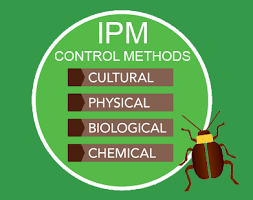Pest Management with GIS and Satellite Monitoring
Traditional farming methods that harm the environment requires pest management with GIS and satellite monitoring. The land on which the crops were grown often becomes unsuitable for further farming due to chemical contamination, soil depletion, or soil salinization.
Today, sustainable growing practices are becoming more widespread, and the need for them is also increasing.
Integrated Pest Management

Integrated Pest Management is a sustainable crop production approach containing eight agreed measures. This approach aims to reduce dependency on pesticides and other chemicals used for crop protection.
In addition, IPM often reduces the costs required for cultivation and improves yields and the quality of agricultural products. Thus, this approach can provide growers with financial sustainability.
GIS and IMP
Insect pests can cause crop losses, resulting in problems covering consumer demand. Timely detection of pests is the key to successful pest control. It is the only way to take timely action and protect the crop.
GIS is a valuable tool in pest control. Applying this technology in agriculture provides valuable opportunities for monitoring for timely detection of threats and management.
Large-scale data collection is required to control pests and diseases and prevent their spread effectively. GIS enables obtaining data and generating accurate models for predicting the distribution of problems with precise geo-referencing.
This technology helps to identify suitable habitat conditions and decipher and evaluate models for understanding the interaction of pests with soil and plants in space.
With the help of GIS, various monitoring measures can be tracked with accurate location information, and pest management decisions can be made based on precise data.
It is possible to develop the most effective plan and select the appropriate methods, including soil solarization for disease control and pest management, by identifying where intervention is needed.
Satellite Monitoring for IPM
Satellite monitoring makes it much easier for farmers to perform daily tasks. Technologies enable farmers that utilize remote monitoring to be aware of all events and changes in the fields.
EOS Data Analytics has developed a digital platform for precision farming EOSDA Crop Monitoring, thanks to which it is possible to track the condition of plants, regardless of the size of the farm.
The platform is rich in features that help users to detect various crop threats on time, including diseases and pests, and take measures to protect crops.
Scouting is an essential component of integrated pest management. This procedure involves regular inspection of the fields to identify deviations in the development of crops.
To successfully apply IPM, growers need data on potential threats for the current season and long term, which can also be obtained through scouting.
The EOSDA Crop Monitoring platform
The EOSDA Crop Monitoring platform’s scouting feature helps users identify problem areas remotely and direct scouts to these areas, providing them with GPS coordinates.
Using the mobile application in the field, scouts can share a detailed report with attached photos with all team members.
Based on satellite monitoring and scouting data, various field activities can be planned and controlled. Regular scouting can help to measure the effectiveness of integrated pest management practices.
Calculating a range of vegetation indices is also available on the EOSDA Crop Monitoring platform, enabling the user to track the crops’ health and changes in the fields.
Vegetation index values can show how problem areas are restored due to the measures taken. If the chosen strategy is ineffective and the pest population increases, it is necessary to resort to other integrated management options.
IPM Market
Organizations and private entrepreneurs that sell various methods of integrated pest management in agricultural products make up the IPM market.
This concept implies the systematic implementation of procedures to combat the use of chemical, biological and physical means. The application of this approach is to reduce risks to human health and the environment.
North America was the largest region in the market in 2021. It is also expected that the market in the Asia-Pacific region will grow significantly in the coming years.
The growth of the IPM market is connected to an increase in the pest population due to climate change. The temperature regulates the physiology and metabolism of many harmful insects.
In other words, due to the temperature rise, the physical activity of insects increases, and they need to eat more to survive. It is one of the significant challenges for agriculture, along with soil salinization.

